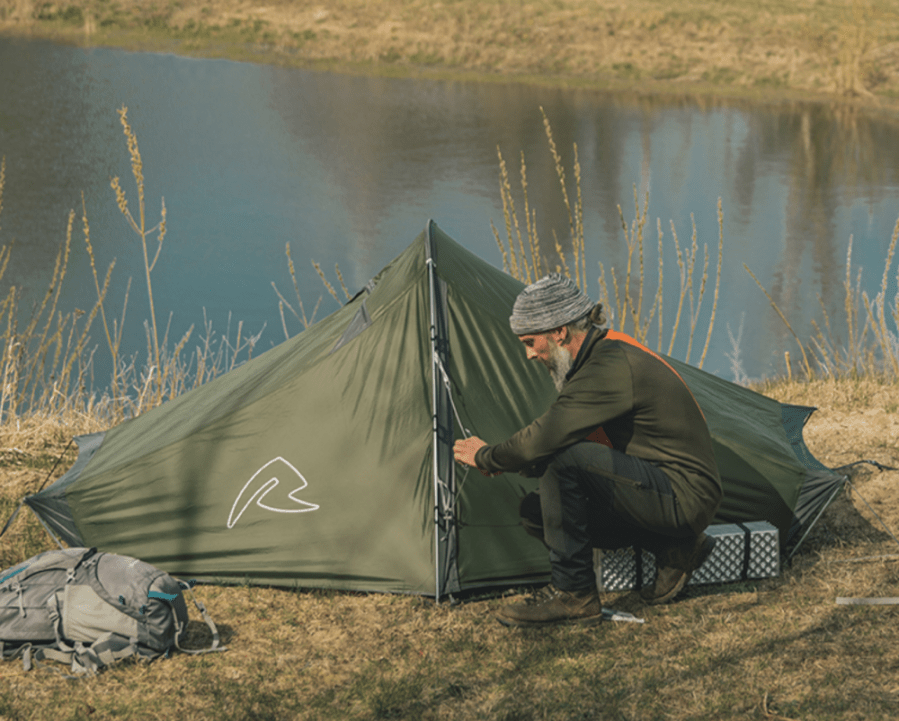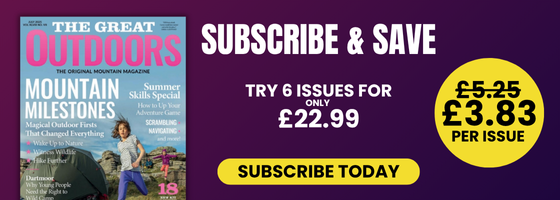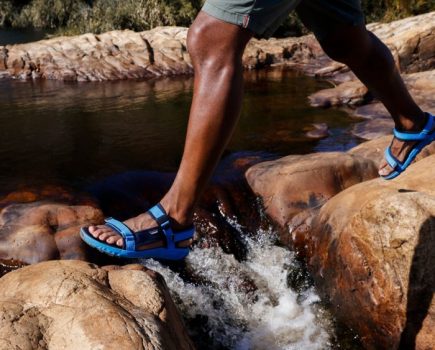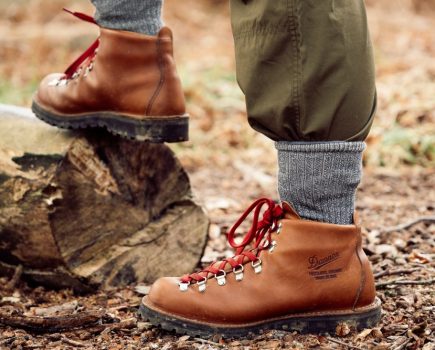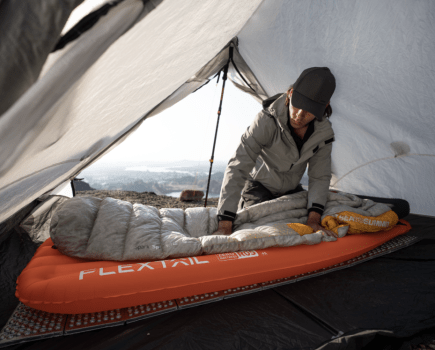One-person backpacking tents come in a wide variety of shapes and sizes. The price tags attached to them vary just as wildly, as does performance. There is a correlation between price and performance, but it is perfectly possible to buy a budget tent that will deliver a comfortable and enjoyable camping experience at a price that won’t break the bank.
Main image: The Robens Starlight EXP 1 | Credit: Oase Outdoors ApS
Regardless of the cost, choosing a tent is about balancing key attributes: weight vs packability vs comfort vs durability vs protection and useability. Quick and easy pitching are desirable too. It’s important for the tent to offer a decent level of useable space whatever the weather – and as our sizes differ, so too will our needs. Think about cover for kit during prolonged rain – that extra space can make all the difference.
The fabric also needs to be sufficiently protective. Look for a hydrostatic head (the measure of how much water can stand on the material before it leaks) over 1000mm for the flysheet, and higher for the groundsheet to protect you from the weather. The shape and dimensions of the tent are down to personal preference, and whether it’s eco-friendly or not will be important to some, too.
Some designs are more wind resistant than others, and therefore better suited to higher camps. Pay attention to ventilation options, and the number of guylines.
Why you can trust The Great Outdoors
The Great Outdoors is here to help you make the most of your time outside. We have been helping people to explore from sea to summit, valley to mountain top for over 40 years. Our gear tests remain completely impartial. If you are wary of websites that only review brands that advertise with them, or sceptical of social media accounts always singing the praises of their latest freebie, you’ve come to the right place! Our reviews rank #1 for rigour, trustworthiness, and independence, and our gear testing team is the most experienced in Britain. With over 200 years’ experience between us, we are professional mountain leaders and instructors, wildlife photographers and rangers, outdoor authors, guidebook writers and trail addicts.
The best budget tents we’ve tested
| Quick List |
|---|
| Best in Test: Robens Starlight EXP 1 (available from Outdoor Action) |
| Lightest in test: Alpkit Soloist (available from Alpkit) |
| Cheapest option: EasyCamp Sarek 1 (available from Cotswold Outdoor) |
| Best for bikepacking: Vango Apex Compact 100 (available from Cotswold Outdoor) |
| Greener Choice: Robens Starlight EXP 1 (available from Outdoor Action) |
Here’s our pick of the best budget tents; the models we think will offer comfort, reliability and practicality, all without crippling the finances. They are all solo designs that cost under £200. The selection we’ve chosen are best suited to three-season use, not for harsh winter conditions. All fit comfortably within a 30-litre daysack.
Best in Test & Greener Choice
Robens Starlight EXP 1
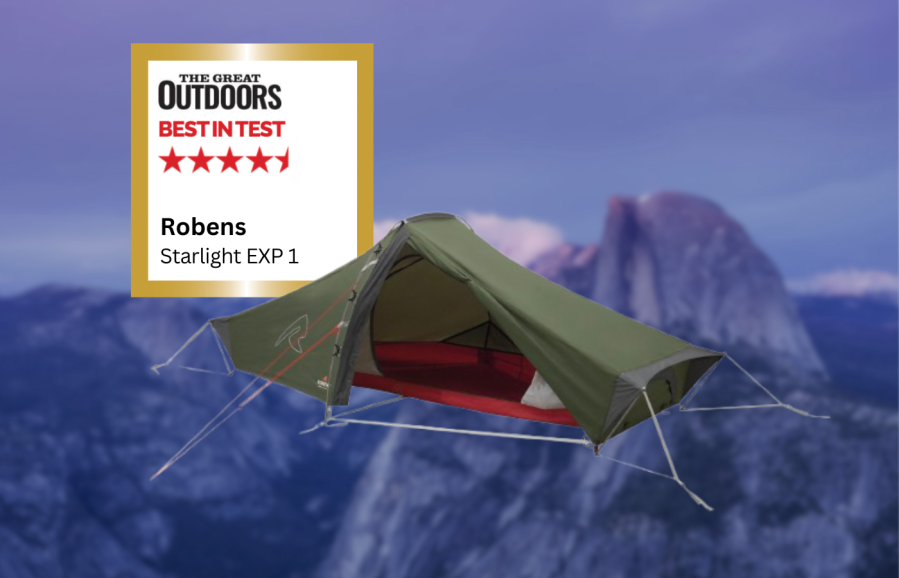
Lara Dunn’s Best in Test
For the money, this is a superbly well-featured – if slightly hefty – three-season backpacking tent.- easy to pitch
- very stable
- spacious
- excellent porch
- weight
| Quick specs | |
|---|---|
| Price: $289.60 / £149.99 Weight: 2302g Pitching: as unit or outer first Flysheet: HydroTex HD RS RECYCLED, 75D recycled polyester 190T ripstop, 5000mm HH Inner: 68D 190T polyester Groundsheet: 75D polyester Taffeta 210T PU coated, 10,000mm HH Poles: 8.5mm, 7001 aluminium anodised Pegs: 8 aluminium pegs Porches: 1 Inner dimensions: width 75cm, length 215cm, height 90cm robens.de |
It feels counter-intuitive to be awarding my heaviest tent the Best in Test, but the Starlight EXP 1 is a budget tent that offers all the performance of a much pricier unit, only sacrificing a genuinely low weight in its pursuit of a keen price point. It’s incredibly easy to pitch, thanks to a single insertable pole that works together with four short sections of permanent pole at the foot and head. Once the inner is attached via nifty little clips that stay secure, it pitches flysheet first or as one. Exterior clips snap onto the pole, with a short stretch of sleeve at the top.
Useable space inside is excellent. There’s room for kit above the head or below the feet, while the porch is genuinely large enough to stow a backpack in, or cook in bad weather. Head height is just about enough for me to be able to sit upright comfortably but I’m only 5’5”, but the overall feel to the inside of the tent is not cramped. For the money, this is a superbly well-featured – if slightly hefty – three-season backpacking tent.
Read more: Lara’s full Robens Starlight EXP 1 review
Best for bikepacking
Vango Apex Compact 100
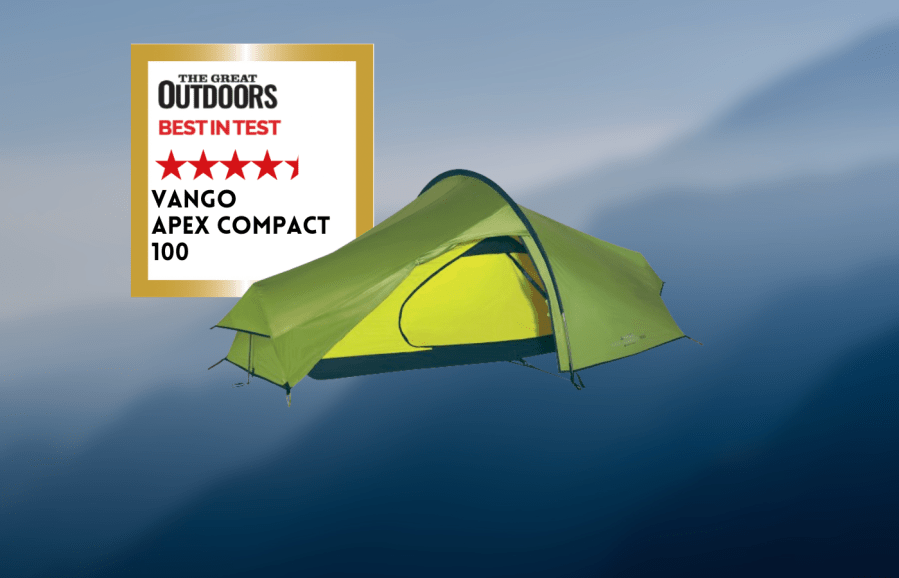
Alex Roddie’s Best in Test
he price is excellent and the tent is well designed, made from hard-wearing materials. Weight is ok for what you get too.- Value
- Durable materials
- Easy to pitch
- Great stuffsack for bikepacking
- Pegs not the best
| Quick specs | |
|---|---|
| Price: £150 Weight: 1.6kg Pitching: inner and fly together Flysheet: 70D Protex Eco polyester ripstop PU 3,000mm HH Inner: 68D polyester with 40D mesh panels Groundsheet: 68D polyester PU 5,000mm HH Poles: 7.9mm aluminium alloy Pegs: 12x shepherd’s crook Porches: 1 Inner dimensions: 95x215x88cm vango.co.uk |
The Vango Apex Compact 100 tent comes in a reasonably sized stuffsack (with a roll-top closure) designed to mount on bike handlebars. With a 70D flysheet, it feels durable and should last well.
It pitches inner and outer together. When I had to throw this tent up in a rainy forest at 10pm, I certainly appreciated this – no risk of the inner getting wet. Pitching was quick and easy.
The porch on the Vango Apex Compact isn’t the biggest but has just enough space, and the inner’s interior has reasonable living room. However, I’m only 5’7”; taller campers may find it restrictive. I found headroom just enough to sit upright. I appreciated the deep bathtub groundsheet and solid inner, totally cutting out the cold wind. Vango’s tension strap technology helps to brace the tent from the inside, too, which really helps in windy situations.
The only real let-down is that the included pegs are basic (if sturdy) alloy shepherd’s crooks. The price is excellent and the tent is well designed, made from hard-wearing materials. Weight is ok for what you get too.
Read more: Alex Roddie’s full Vango Apex Compact 100 review
Best for stability
Robens Arch 2
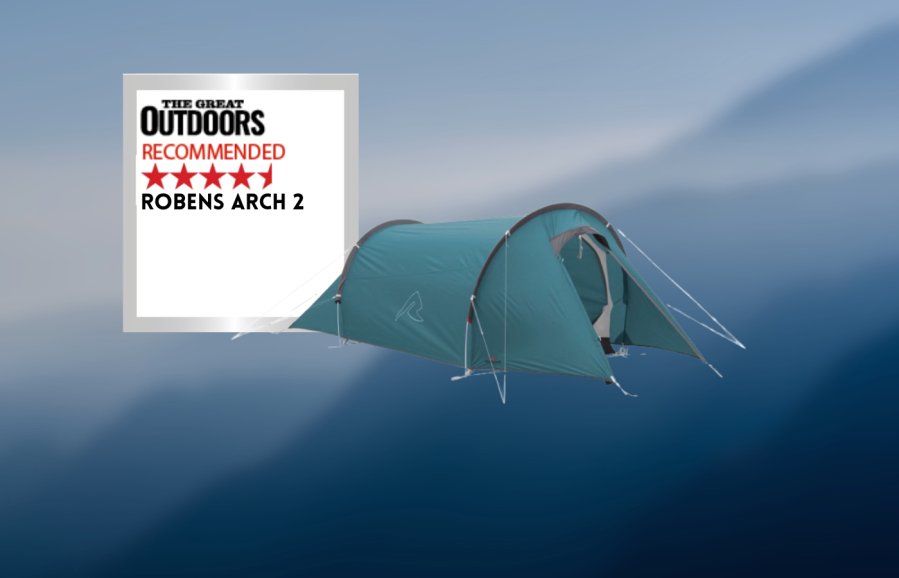
Alex Roddie Recommends
Overall, this is a durable, stable tent that can handle bad weather. I’d even suggest that it’s capable as a “starter” winter backpacking tent if on a budget. £180.99 really is excellent value.- Durable materials
- Weather resistant
- Quick pitching
- Great value
- Decent living space
- Difficult to repack
- Weight
- Poor pegs
| Quick specs | |
|---|---|
| Price: £180.99 Weight: 2.5kg Pitching: inner and fly together Flysheet: 75D polyester 190T HydroTex Core 3,000mm HH Inner: 68D polyester 190T Groundsheet: 75D polyester Taffeta 185T PU 6,000mm HH Poles: 8.5mm aluminium #7001 T6 Pegs: 14x alloy wire pegs Porches: 1 Inner Dimensions: 120x220x95cm robens.de |
Although the Robens Arch 2 tent is the heaviest in this year’s round-up of budget tents, it has a few qualities that elevate it above the competition. I often think that Robens gear hits an attractive sweet spot between performance and price, and the Arch 2 fits that formula perfectly.
Pitching couldn’t be simpler. The whole thing goes up in one go, slide the poles into the sleeves, and peg out. It’s one of the quickest tents to pitch of those tested – a major advantage in filthy weather. The tunnel design is stable if pitched tail to wind, and when all the guys are pegged out it will handle moderate gusts (Robens test it up to a maximum of 150km/h, although I wouldn’t want to push it that far).
Overall, this is a durable, stable tent that can handle bad weather. I’d even suggest that it’s capable as a “starter” winter backpacking tent if on a budget. £180.99 really is excellent value for what you get, and at this price the small downsides are easy to forgive. The weight is high thanks to the burly materials, the included pegs are extremely basic, and it’s difficult to squeeze back into its stuffsack. But it should last well and will handle most British mountain conditions
Read more: Alex’s full Robens Arch 2 review
Best for ultralight backpacking
Alpkit Soloist
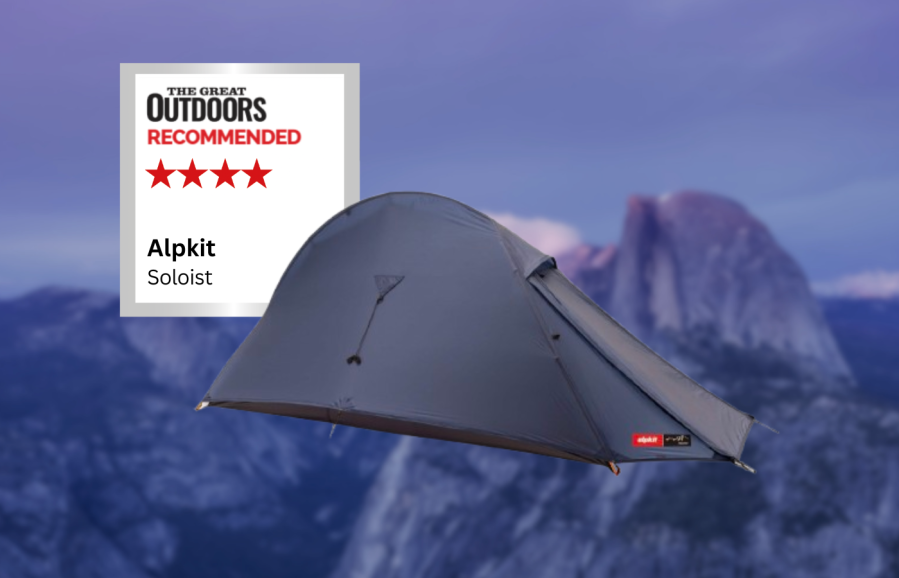
Lara Dunn recommends
This tent stands apart in that a separate groundsheet is available (at extra cost) which makes for increased versatility in pitching, giving an ultra-lightweight option.- very light
- compact size
- versatile pitching
- fairly small porch
- lots of mesh
| Quick specs | |
|---|---|
| Price: $204 / £149.99 Weight: 1328g Pitching: outer first Flysheet: 15D, silicone coated ripstop nylon with PU backer, 3000mm HH Inner: 15D breathable ripstop nylon Groundsheet: 20D ripstop nylon PU, 5000mm Poles: Diameter, 7001-T6 alloy Pegs: 11 ‘v’ shaped alloy pegs Porches: 1 Inner dimensions: width 77cm, length 220cm, height 95cm alpkit.com |
The only non-green tent in the test, the Alpkit Soloist is still a sufficiently subtly coloured tent to be useful for stealth camping missions. It’s extremely lightweight and has a very modest packsize. The semi-geodesic design pitches outer first, with a single, jointed pole that tucks into eyelets in the flysheet and fastens along the pole length with Velcro.
Pitching proved quite unwieldy in gusty wind, given how light the whole thing is. Once up, the flysheet sits securely without needing to be pegged out (although it is still advisable) and the inner tent hooks quickly and easily to the outer. With guylines in place, this is a secure tent that gives excellent protection from wind and driving rain.
The poles are very lightweight, which would give me some cause for concern if the wind got too vigorous. In fairness, this is not a tent for winter conditions anyway. This tent stands apart in that a separate groundsheet is available (at extra cost) which makes for increased versatility in pitching, giving the ultra-lightweight option of pitching outer only or the warm, dry weather option of inner only.
Read more: Lara’s full Alpkit Soloist review
Lightest in test
Alpkit Tarpstar 2
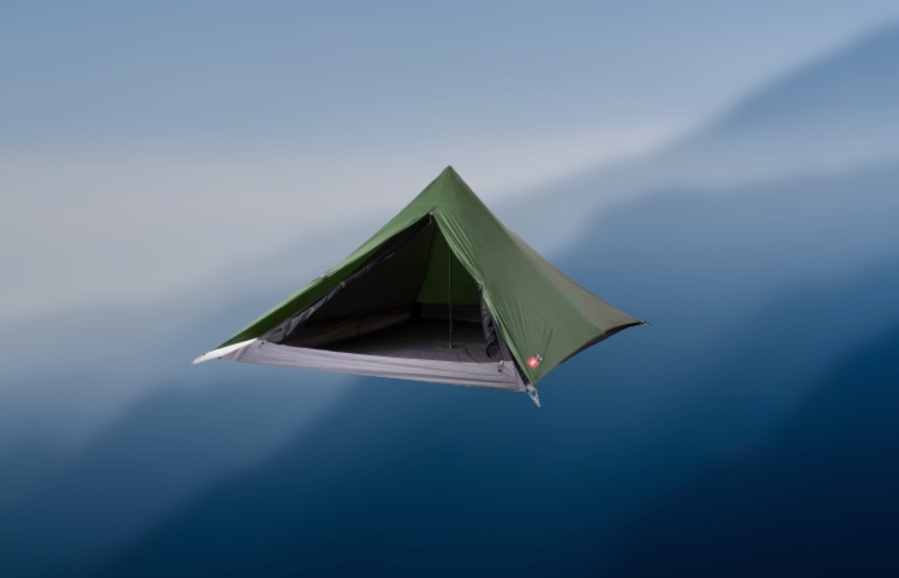
Alex Roddie’s verdict
This tent’s strengths are unbeatable inner space, very low weight and pack size. It would be ideal for backpacking in sheltered valley sites if you know you’ll never need to cook inside your tent.- Living space
- Simple design
- Lightweight
- Small pack size
- No porch
- Flappy in high winds
- Awkward to pitch
| Quick specs | |
|---|---|
| Price: £179.99 Weight: 1.19kg Pitching: fly first Flysheet: 20D polyester ripstop sil/PU 3,000mm HH Inner: 20D nylon ripstop Groundsheet: 20D nylon ripstop sil/PU 3,000mm HH Poles: trekking pole or 13.5mm carbon Vertex Tarp Pole (not included) Pegs: 12x alloy V angle pegs Porches: none Inner dimensions: 200x250x130cm alpkit.com |
The Alpkit Tarpstar 2 is pyramid tarp tent with inner – a long-established design that excels in terms of weather resistance for the weight. It pitches with a single pole in the centre. You either need to use your own trekking pole or Alpkit’s carbon Vertex Tarp Pole (not included). One downside is that, if using the tent with the inner, the bottom of the pole has to rest on the groundsheet floor with minimal reinforcement – and it’s a bit awkward to pitch, because the pole has to go inside the inner.
The flysheet, which can be easily pitched alone as a tarp, offers massive interior coverage. Wind resistance is, unfortunately, not as good as other pyramids I’ve used, because the edges of the tarp are cut flat – no catenary curve to take in slack. It can be flappy in high winds.
The mesh inner has a good bathtub groundsheet but sits very close to the flysheet, which means that condensation can drip through. There is no porch. The inner extends all the way to the edge of the door.
This tent’s strengths are unbeatable inner space, very low weight and pack size. It would be ideal for backpacking in sheltered valley sites if you know you’ll never need to cook inside your tent. But there are better options for mountain use.
Read more: Alex Roddie’s full Alpkit Tarpstar 2 review
Highlander Respite 1 Person Tunnel Tent
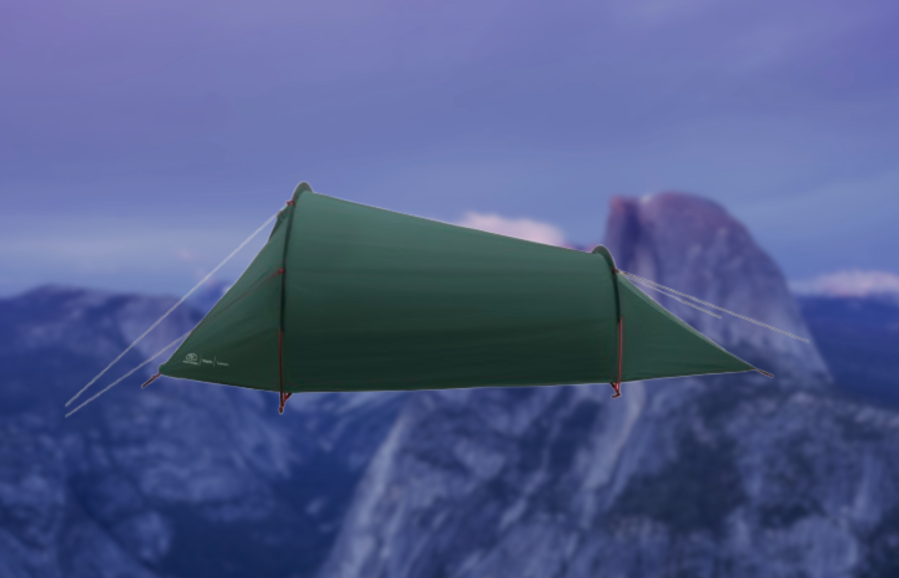
Lara Dunn’s verdict
At the price, it feels like a useful and cost-effective option for camping where good weather is expected, but better options are available if rain is likely.- spacious
- good front porch
- pitching takes practice
| Quick specs | |
|---|---|
| Price: $177 / £129.99 Weight: 1744g Pitching: as a unit or outer first Flysheet: 75D, 210T polyester ripstop, 4000mm HH Inner: Breathable polyester with DWR Groundsheet: 190T polyester, 5000mm HH Poles: Front 8.5mm, rear 7.9mm, aluminium 7001 Pegs: 13 aluminium 7001 pegs Porches: 1 Inner dimensions: width 100cm, length 210cm, height 80cm highlander-outdoor.com |
The dark-green Highlander Respite 1 Person tunnel tent is extremely easy to erect, pitching flysheet first or inner and outer together as one. Two, different sizes of aluminium pole insert easily to give immediate structure to the tent, but it isn’t until its four guylines are deployed that the shelter has structure. A good deal of practice is required to position lines correctly for adequate tension, in order to avoid sagginess or water pooling. It was also difficult to arrange tension sufficiently without the inner and outer touching in bad weather, a shame given how waterproof the polyester ripstop flysheet material is. Additional guy points at the sides might help mitigate this, but the design does not currently include these.
Space inside the tent is reasonable, thanks to its decent length and generous width at widest point, with enough clearance for both a mat and kit. There’s even a stash pocket and a short washing line inside. However, the low head clearance does mean it can feel stuffy, despite a mesh ventilation panel at the feet.
The front door also doubles as ventilation and features a full-sized mesh panel, making for good insect proofing. The porch at the front of the tent is usefully deep and well-sized for either storage of a mid-sized pack and boots, or for cooking in bad weather. At the price, it feels like a useful and cost-effective option for camping where good weather is expected, but better options are available if rain is likely.
Read more: Lara Dunn’s full Highlander Respite 1 Person Tunnel Tent review
EasyCamp Sarek 1
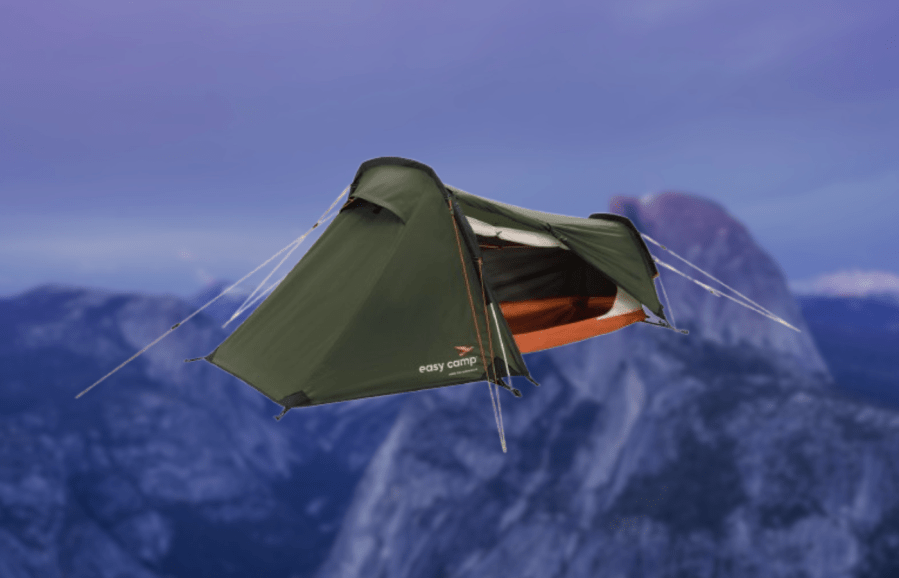
Lara Dunn’s verdict
For the price, it’s not a bad budget backpacking option but it’s probably better suited to Duke of Edinburgh expeditions- low price
- easy to pitch
- small porch
- compact feeling living space
| Quick specs | |
|---|---|
| Price: $115 / £84.99 Weight: 1936g Pitching: as unit or outer first Flysheet: WeatherGuard 3000 180T polyester PU coated, PFC free water repellency, 3000mm Inner: Breathable polyester Groundsheet: 75D polyester Taffeta 185T PU coated, 5000mm HH Poles: 8.5mm, 7001 aluminium Pegs: 4 aluminium pegs Porches: 1 Inner dimensions: width 75cm, length 225cm, height 80cm easycamp.com |
There’s a lot to love here with the EasyCamp Sarek 1 and it’s the cheapest in this test, but there are a few niggles that make it less than perfect for experienced or more demanding users. The Sarek 1 consists of two aluminium poles, a fly sheet and inner with integral ground sheet. It pitches fly first, or as one (once clipped in with its simple but effective toggle and ring fastening). Some re-fastening can be necessary if pitched as one.
Marketed at trekkers and cycle tourists, the tent – which is stealth camping friendly, dark green – claims to have a generous porch that runs along the side where the entrance is, but I found it to be far too shallow to be genuinely useful in inclement weather, either for dry storage or cooking.
The tunnel tent design goes up quickly, but guylines are needed to finish the job. It takes some time and effort with positioning and tightening the guylines to achieve a decent tension to prevent sagging and water collection. For the price, it’s not a bad budget backpacking option but it’s probably better suited to Duke of Edinburgh type expeditions, rather than adult hikers looking for a backpacking all-weather home on multi-day walks.
Read more: Lara Dunn’s full EasyCamp Sarek 1 review
Wild Country Coshee Micro Tent

Alex Roddie’s verdict
If you are looking for a durable, weather-resistant tent with a low profile, this could be worth a look. But there are better options for the weight and price that offer much better living space.- Easy pitching
- Great in high winds
- Durable materials and design
- Poor living space
- Hard to get inside
| Quick specs | |
|---|---|
| Price: £180 Weight: 1.45kg Pitching: inner and fly together Flysheet: 68D Stormtex polyester PU 4,0000mm HH Inner: 68D polyester Groundsheet: Aqua Stop 68D PU 5,000mm Poles: 8.5mm Superflex alloy Pegs: 8x alloy V angle pegs Porches: 1 Inner dimensions: 52x211x64cm terra-nova.co.uk |
The Wild Country Coshee Micro is an angled tunnel tent with two poles. It pitches as a unit and in only a few minutes – of all the tents tested it was the quickest and easiest to get a taut pitch. It has a burly 68D polyester flysheet (although the material is not ripstop) and the 68D groundsheet also feels reassuringly durable. I liked the solid inner with good ventilation. The included poles are of good quality. The V angle pegs perform ok but bend easily. One downside is that only 8 pegs were included, but there were lots more potential pegging points.
The structure is very low to the ground and fantastically stable in high winds. But the doorway is at knee height; you have to crawl in. And the living space, even for my 5’7” frame with medium build, was extremely cramped. I found both head and feet pressed against the inner, and there’s no room to sit up. The porch is just about big enough for shoes and a small pack.
If you are looking for a durable, weather-resistant tent with a low profile, the Wild Country Coshee Micro could be worth a look. But there are better options for the weight and price that offer much better living space.
Read more: Alex Roddie’s full Wild Country Coshee Micro Tent review
How we test
Lara used the tents on backpacking adventures in early spring at lower-level locations in mid-Wales. Temperatures were variable but weather was largely favourable. Weights are for total pack including stuffsack, poles and pegs and measured on Lara’s scales. These reviews were first published in the August 2025 issue of The Great Outdoors.
What to look for when choosing a value tent
When you’re choosing a two-person tent our advice is to not simply look for the cheapest product. That’s because really low budget tents can be, quite frankly, rubbish. They often end up as rubbish on landfill, too, unfortunately. When it comes to sleeping out in the elements, you’re going to want something you can fully trust – you want to be able to sleep safe and sound.
Flysheet Materials
Silicone coated fabrics tend to be light and durable, but are expensive. PU coated nylon or polyester costs less but is heavier. A good value tent should be made of high-quality materials that are durable and long-lasting. The tent should be able to withstand wear and tear over time and hold up well to the elements. Look for tents that are made of sturdy materials such as ripstop nylon or polyester, with reinforced seams and sturdy zippers.
A good indicator of the durability is the denier rating of the fabric. The higher the number, the more durable the fabric, though it can also – though not in all cases – correlate with overall weight.
Inner Materials
The interior of the tent – usually nylon or polyester – needs to be breathable enough to keep condensation low while offering protection from the wind and insects. Mesh doors or windows are handy for warmer conditions.
Groundsheets
These should be made of heavier fabrics and have a higher hydrostatic head than the flysheet. Some manufacturers suggest a separate additional groundsheet, which add weight and cost.
Inner Dimensions
The inner should be long enough for sleeping bag and mat to clear the ends. Headroom should ideally allow the camper to sit upright comfortably at the apex of the inner. A minimum of 90cm is useful. Tent capacity refers to the number of people the tent can accommodate. It is essential to choose a tent that is the right size for group and your trip. A tent that is too small can obviously be cramped and uncomfortable, while a tent that is too big can be difficult to heat and may not provide adequate weather protection.
Poles
Poles should be easy to attach or insert into their sleeves. Colour coding can help with comprehension at the end of a long walk! Plastic and fiberglass poles tend to be the least reliable materials for poles as they can break under pressure from wind or when the tent is in transit in your hiking backpack.
Aluminum tends to be the most popular tent pole material, as it is lightweight, strong, and durable. It is also relatively affordable and can be used in a wide range of tent types. Carbon fiber and DAC Featherlite poles (a type of aluminum alloy) are more expensive than aluminum poles, but they are also more lightweight and can provide better performance in high winds.
Pegs
Thin pegs are good for hard ground while wider ones are good for soft, a mix is handy. The simple addition of a cord loop on the end of a straight peg can make pulling it out of the ground much easier when striking camp. Pack spares.
Guylines
Essential for stability in strong winds.
Porches
Porches should be big enough for safe cooking and the storage of kit. Porches can be at the ends or sides, depending on design. Check what the porch space is like and consider whether it’ll be big enough to store your kit while still giving you space to cook inside on any rainy days. In relation to this, check what the accessibility is like. If you’re sharing the tent with another person, you want the access in and out to be nice and easy for both of you.
Doors
Multiple opening options can be useful to enable easy access and optimal views. Two door tents are very useful as they allow you to clamber out of the tent without having to climb over your tent buddy – but the drawback is that the extra door can often add a bit of extra weight to the tent.
Ventilation
Good ventilation is essential in a tent to prevent condensation and keep the occupants comfortable. Look for tents that have adequate ventilation at the top and at the base of the tent to allow for airflow and prevent stuffiness and moisture build up inside. Reduce condensation with protected vents or upper door zips that can left open.
Pitching
Some tents pitch flysheet first, some inner first and some all as a unit. Inner first enables effective tensioning but can be a problem in rain. Flysheet first and single unit pitching is easier and keeps everything dry, but can be hard to tension correctly. Practice pitching before taking a tent on a trip.
Weather resistance
Tent structure is crucial when it comes to wind resistance. Geodesic tents, which have numerous poles that cross at various points, will tend to be the most reliable in strong winds, followed by semi-geodesic tents. Tunnel tents are also considered to be reliable in strong winds – so long as the narrow end of the tent is pitched into the wind and the wind direction doesn’t switch.
Dome tents are generally designed to be stable in mild to moderate winds, but may struggle in extreme conditions. The rounded shape can make them more susceptible to wind than other types of tents, such as geodesic or tunnel tents.
Waterproofness
In terms of rain protection, the hydrostatic head is a good indicator there – the higher the number, the more reliable the tent will be. The lowest hydrostatic head rating that is generally considered to be waterproof for a tent is 1000mm. Many tents have a higher rating, ranging from 1500mm to 3000mm or more, which provides extra protection against heavy rain or other wet conditions.
It’s worth noting that the hydrostatic head rating is just one factor that contributes to a tent’s overall waterproofness. Other factors, such as the quality of the tent seams and the design of the tent’s rainfly, can also affect how well the tent keeps you dry in wet conditions.
Price
Finally, consider the price when buying a good value tent. A good value tent should be affordable while still offering the necessary features and durability to meet your needs. Consider your budget and compare prices and features to ensure you are getting the best possible value for your money.

